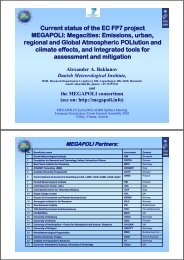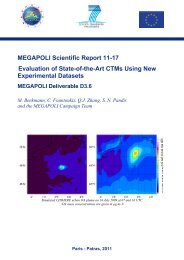D E S C R I P T I O N O F W O R K - MEGAPOLI - Dmi
D E S C R I P T I O N O F W O R K - MEGAPOLI - Dmi
D E S C R I P T I O N O F W O R K - MEGAPOLI - Dmi
Create successful ePaper yourself
Turn your PDF publications into a flip-book with our unique Google optimized e-Paper software.
<strong>MEGAPOLI</strong> 212520<br />
oxidants, the evolution of tropospheric oxidation, the links between air quality and climate change, and<br />
quantification of model uncertainty through detailed comparisons between model results and atmospheric<br />
measurements. He has participated in a number of international projects, including NARE, TRACE-P,<br />
ACCENT and HTAP and has contributed to assessment reports by WMO and IPCC.<br />
Maria Russo, Dr., Res. Assoc., works at CAS; responsible for developing the high-resolution and mesoscale<br />
versions of the UKCA model, and is involved in providing modelling support to a number of measurement<br />
campaigns related to EU projects (ACTIVE, SCOUT-O3, AMMA).<br />
Recent and relevant publications<br />
Wild, O., M.J. Prather (2006): Global tropospheric ozone modelling: Quantifying errors due to grid resolution, J.<br />
Geophys. Res., 111, D11305, doi:10.1029/2005JD006605.<br />
Zeng, G., J.A. Pyle (2005), Influence of El Nino Southern Oscillation on stratosphere/troposphere exchange and the<br />
global tropospheric ozone budget, Geophys. Res. Lett., 32, doi:10.1029/2004GL021353.<br />
Wild. O., P. Pochanart, H. Akimoto (2004): Trans-Eurasian transport of ozone and its precursors, J. Geophys. Res.,<br />
109, D11302, doi:10.1029/2003JD004501.<br />
Wild, O., et al. (2004): CTM ozone simulations for spring 2001 over the Western Pacific: Regional ozone production<br />
and its global impacts, J. Geophys. Res., 109, D15S02, doi:10.1029/2003JD004041.<br />
B.2.3 Consortium as a whole<br />
Description of the consortium<br />
The <strong>MEGAPOLI</strong> consortium consists of funded participants, non-funded international participants and end<br />
users/stakeholders.<br />
Overview of the Consortium and Commitment<br />
The <strong>MEGAPOLI</strong> consortium consists of 23 full partners from 11 European countries, 12 international<br />
research non-funded partners from USA, Canada, Mexico, India, Chile and Thailand, and 9 end<br />
users/stakeholders. Figures 8 and 9 show the geographical location of all the consortium partners and<br />
collaborators. All organizations are highly regarded internationally in their respective field. Collectively and<br />
uniquely, <strong>MEGAPOLI</strong> represents a true integration of capacity from hitherto disparate fields, namely, the<br />
climate change and air quality communities, from the megacity- to regional and global scales, including both<br />
measurement and modelling groups. The number of partners reflects the expertise that is required to<br />
undertake the work programme and benefits from partners having complementary roles. A balanced<br />
consortium was chosen to assemble all knowledge, research facilities, models and experiences together to do<br />
the research, needed to meet the objectives of <strong>MEGAPOLI</strong>. The key research groups are distributed across<br />
many parts of Europe, bringing together the necessary know-how in the necessary fields including<br />
atmospheric dynamics, atmospheric chemistry, urban, regional and global scale modelling, megacity<br />
features, emissions and ground-based, laboratory, aircraft and satellite measurement groups. The scientific<br />
nature of urban aerosol induced climate forcing and urban-regional air quality requires this broad based<br />
expertise and skill level. Over the duration of the project <strong>MEGAPOLI</strong> will mobilise in excess of 150<br />
international scientists. Although there is an emphasis on research, strong interaction will exist with users,<br />
megacities administrations and external experts through the Project Advisory Board, user workshops and the<br />
Global Stakeholder forum.<br />
All participants are fully committed to the project and its aims and the work programme is an essential part<br />
of their organization's long-terms strategies demonstrating a high level commitment from all participants.<br />
The complementary roles for each partner are summarised in Table 2.3.<br />
93




